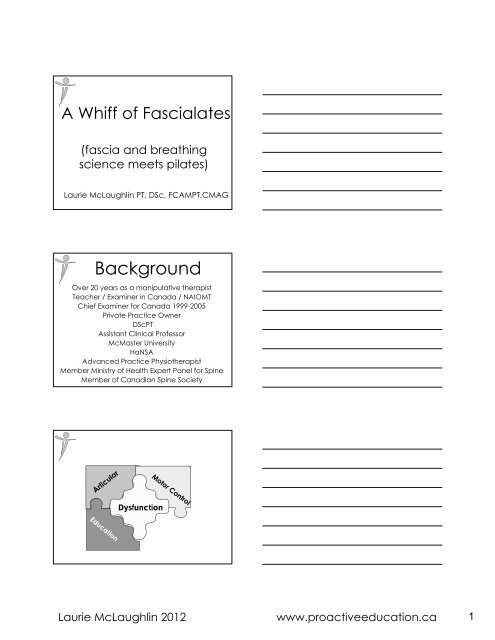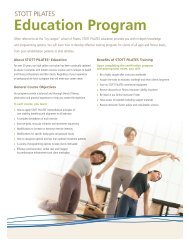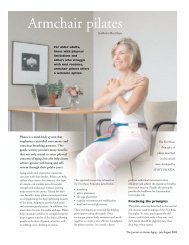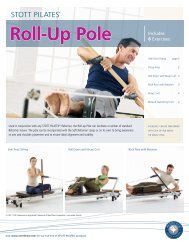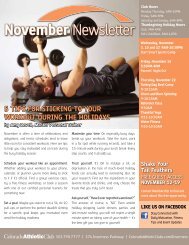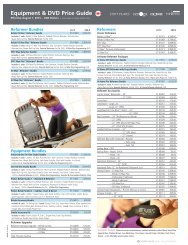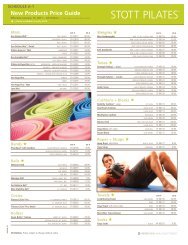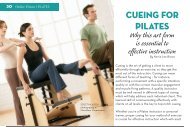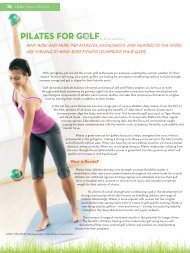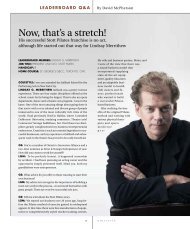Presentation Notes: A Whiff of Fascialates - Merrithew.com
Presentation Notes: A Whiff of Fascialates - Merrithew.com
Presentation Notes: A Whiff of Fascialates - Merrithew.com
Create successful ePaper yourself
Turn your PDF publications into a flip-book with our unique Google optimized e-Paper software.
A <strong>Whiff</strong> <strong>of</strong> <strong>Fascialates</strong><br />
(fascia and breathing<br />
science meets pilates)<br />
Laurie McLaughlin PT, DSc, FCAMPT,CMAG<br />
Background<br />
Over 20 years as a manipulative therapist<br />
Teacher / Examiner in Canada / NAIOMT<br />
Chief Examiner for Canada 1999-2005<br />
Private Practice Owner<br />
DScPT<br />
Assistant Clinical Pr<strong>of</strong>essor<br />
McMaster University<br />
HaNSA<br />
Advanced Practice Physiotherapist<br />
Member Ministry <strong>of</strong> Health Expert Panel for Spine<br />
Member <strong>of</strong> Canadian Spine Society<br />
Dysfunction<br />
Laurie McLaughlin 2012<br />
www.proactiveeducation.ca<br />
1
Practice Based<br />
Evidence<br />
Clinical Observations and Hypothesis:<br />
Must be something affecting function and<br />
movement other than just local articular<br />
and muscular tissues<br />
Has continuity<br />
Is a <strong>com</strong>munication system<br />
Transmits force / load<br />
Is responsive<br />
Fascial / Connective<br />
Tissue Anatomy<br />
Laurie McLaughlin 2012<br />
www.proactiveeducation.ca<br />
2
Fascia<br />
The Connective Tissue that<br />
can be seen by the<br />
naked eye!<br />
Gray’s Anatomy<br />
Connective<br />
Tissue<br />
Extracellular Matrix<br />
Fibrous Proteins<br />
Ground Substance<br />
Secreted by connective tissue cells<br />
Gray’s Anatomy<br />
Connective Tissue<br />
Cells<br />
The cells are imbedded in the<br />
matrix<br />
Resident Cells<br />
Fibroblasts<br />
Adipocytes<br />
Mesenchymal stem cells<br />
Migrant Cells<br />
Macrophages<br />
Lymphocytes<br />
Mast cells<br />
Granulocytes<br />
Gray’s Anatomy<br />
Laurie McLaughlin 2012<br />
www.proactiveeducation.ca<br />
3
Connective<br />
Tissue Roles<br />
Structural (mechanics <strong>of</strong> ECM)<br />
Defensive (cellular <strong>com</strong>ponents)<br />
Organizes and influences growth<br />
and differentiation <strong>of</strong><br />
surrounding tissue<br />
Gray’s Anatomy<br />
Connective<br />
Tissue Categories<br />
Blood<br />
Bone<br />
Cartilage<br />
General Connective Tissue<br />
Gray’s Anatomy<br />
Connective Tissue /<br />
Extracellular Matrix<br />
Insoluble Protein Fibres<br />
Mostly collagen<br />
Allows for tensile properties<br />
Comprises ~ 30% body’s protein<br />
Proteins with<br />
adhesive and water<br />
binding capacities<br />
Elastin<br />
Provides resilience<br />
Gray’s Anatomy<br />
Laurie McLaughlin 2012<br />
www.proactiveeducation.ca<br />
4
Connective Tissue /<br />
Extracellular Matrix<br />
Distributes mechanical stresses<br />
Provides structural framework for cells to<br />
attach to or move in<br />
Provides watery environment where<br />
metabolites, gases, and nutrients diffuse<br />
readily among cells and the vessels<br />
going through it Gray’s Anatomy<br />
General Connective<br />
Tissue<br />
Irregular<br />
Loose, dense<br />
and adipose<br />
Connective<br />
Tissue<br />
Gray’s Anatomy<br />
Regular<br />
Regularly oriented<br />
fibres in response to<br />
stresses<br />
Fascial sheets<br />
Aponeuroses<br />
Ligaments<br />
Tendons<br />
Loose Connective<br />
Tissue<br />
Meshwork <strong>of</strong> thin collagen and<br />
elastin fibres<br />
“Extensively distributed”<br />
Provides for connection between<br />
tissues yet allows movement<br />
Gray’s Anatomy<br />
Laurie McLaughlin 2012<br />
www.proactiveeducation.ca<br />
5
Loose Connective<br />
Tissue<br />
“Interstitial “loose” connective tissue<br />
constitutes a continuous network<br />
enveloping all limb muscles, bones,<br />
and tendons, extending into<br />
connective tissue planes <strong>of</strong> pelvic and<br />
shoulder girdles, abdominal and chest<br />
walls, neck and head”<br />
Langevin 2002<br />
Loose Connective<br />
Tissue<br />
“This tissue network is also continuous<br />
with more specialized connective<br />
tissues such as periosteum, perimysium,<br />
perineurium, pleura, peritoneum, and<br />
meninges.”<br />
“Connective tissues permeate all organs<br />
and surround all nerves, blood vessels<br />
and lymphatics.”<br />
Langevin 2002<br />
Connective Tissue<br />
Consists <strong>of</strong> both a delicate web with fine<br />
branches penetrating all tissues,<br />
and<br />
major “trunks” forming connective tissue planes<br />
and linking all parts <strong>of</strong> the body with each<br />
other<br />
Langevin 2004<br />
Laurie McLaughlin 2012<br />
www.proactiveeducation.ca<br />
6
Dense Connective<br />
Tissues<br />
Found in places <strong>of</strong> high mechanical<br />
loading:<br />
Periosteum<br />
Muscle<br />
Nerve sheaths<br />
Where there is a need for protection:<br />
capsules <strong>of</strong> organs and glands<br />
adventitia <strong>of</strong> large vessels<br />
Gray’s Anatomy<br />
Connective Tissue<br />
2 main functions:<br />
1. Separate and allow gliding<br />
2. Connect or transfer force<br />
• Fascia can affect muscle quality<br />
• If it be<strong>com</strong>es a tough leathery<br />
container, <strong>com</strong>presses or torsions, the<br />
muscle can’t function properly<br />
• Muscle will take the shape <strong>of</strong> the<br />
container and its function depends on<br />
the shape or space it is given<br />
Voyer<br />
Laurie McLaughlin 2012<br />
www.proactiveeducation.ca<br />
7
Muscle Connective<br />
Tissue<br />
Endomysium – surrounds individual my<strong>of</strong>ibres<br />
Perimysium – separates and envelopes<br />
my<strong>of</strong>ibre bundles,<br />
- more prevalent in tonic muscles<br />
- greatest amount <strong>of</strong> blood vessels within it<br />
-increases passive muscle stiffness<br />
Epimysium – around the whole muscle<br />
Schleip 2006<br />
Muscle Connective<br />
Tissue<br />
Provide intramuscular pathways and<br />
reinforcement for nerves, blood vessels and<br />
lymphatics<br />
Extensive matrix <strong>of</strong> connected tunnels<br />
Muscle fibre # doesn’t change after birth<br />
Interaction between muscle cells and ECM<br />
governs muscle turnover, hypertrophy and<br />
injury repair<br />
Muscle Connective<br />
Tissue<br />
Specialized connective tissue runs between<br />
muscles and bone<br />
Dynamic connection or ‘dynament’<br />
Structural support adapts to changing distance<br />
between bones through range<br />
Different muscle to muscle<br />
Nerve endings where stress is high<br />
Laurie McLaughlin 2012<br />
www.proactiveeducation.ca<br />
8
Fascial Compartments<br />
Contraction <strong>of</strong> muscles within a <strong>com</strong>partment<br />
increases pressure increasing contractile<br />
efficiency <strong>of</strong> other muscles in the<br />
<strong>com</strong>partment<br />
Provides cyclic pressure changes in gait serving<br />
as a ‘secondary heart pump’<br />
Assisting with perfusion to the muscle itself<br />
Fascial Contractility<br />
Fascia is able to actively contract<br />
My<strong>of</strong>ibrils are present in fascia and<br />
respond to smooth muscle<br />
stimulants and relaxants<br />
Schleip 2006<br />
Practice Based<br />
Evidence<br />
Clinical Observations and Hypothesis:<br />
Must be something affecting function and<br />
movement other than just local articular<br />
and muscular tissues<br />
Has continuity<br />
Is a <strong>com</strong>munication system<br />
Transmits force / load<br />
Is responsive<br />
Laurie McLaughlin 2012<br />
www.proactiveeducation.ca<br />
9
Laurie McLaughlin 2012<br />
www.proactiveeducation.ca<br />
10
Laurie McLaughlin 2012<br />
www.proactiveeducation.ca<br />
11
Continuity<br />
Anatomy limited by dissection process<br />
Described by nearby structures<br />
Doesn’t highlight the tissue as a whole<br />
Practice Based<br />
Evidence<br />
Clinical Observations and Hypothesis:<br />
Must be something affecting function and<br />
movement other than just local articular<br />
and muscular tissues<br />
Has continuity<br />
Is a <strong>com</strong>munication system<br />
Transmits force / load<br />
Is responsive<br />
Laurie McLaughlin 2012<br />
www.proactiveeducation.ca<br />
12
Fascia and Nerves<br />
Nerves are covered in 3 layers <strong>of</strong> fascia:<br />
These fascial layers are innervated by the<br />
nervi nervorum<br />
Bove 2008<br />
Tibial Nerve<br />
So…<br />
Nerves are covered in<br />
(innervated) fascia<br />
Fascia throughout the body is<br />
innervated<br />
Can we separate them<br />
NO!<br />
Laurie McLaughlin 2012<br />
www.proactiveeducation.ca<br />
13
Acupuncture<br />
Meridians theorized to follow fascial planes<br />
Hypothesized needle grasp due to<br />
mechanical coupling between needle<br />
and connective tissue<br />
Hypothesized needle manipulation transmits<br />
mechanical signal to connective tissue<br />
cells via mechanotransduction<br />
Langevin 2004<br />
Traditional Chinese Medicine<br />
Helms Acupuncture Energetics<br />
Myers Anatomy Trains<br />
Traditional Chinese Medicine<br />
Helms Acupuncture Energetics<br />
Myers Anatomy Trains<br />
Laurie McLaughlin 2012<br />
www.proactiveeducation.ca<br />
14
Traditional Chinese Medicine<br />
Helms Acupuncture Energetics<br />
Myers Anatomy Trains<br />
Acupuncture Points and<br />
Cortical Communication<br />
Acupuncture points in the foot have been<br />
found to stimulate the occipital lobes on FMRI<br />
Stimulation <strong>of</strong> the eye directly by using light<br />
results in similar activation<br />
Points stimulated 2-5cm away do not result in<br />
occipital stimulation<br />
Cho 1998<br />
Mechanotransduction<br />
Ability <strong>of</strong> cells to perceive and biochemically<br />
interpret mechanical forces<br />
Mechanical force effect on cell shape<br />
emerging as key regulatory mechanism in<br />
cells, tissues and organs<br />
Mechanotransduction likely has widespread<br />
effects on connective tissue cells and<br />
vascular/neural elements present within it<br />
Langevin 2003,2005<br />
Laurie McLaughlin 2012<br />
www.proactiveeducation.ca<br />
15
Functional<br />
Positions<br />
Practice Based<br />
Evidence<br />
Clinical Observations and Hypothesis:<br />
Must be something affecting function and<br />
movement other than just local articular<br />
and muscular tissues<br />
Has continuity<br />
Is a <strong>com</strong>munication system<br />
Transmits force / load<br />
Is responsive<br />
Force Transmission<br />
Within the muscle via Fascia<br />
Between muscles via Fascia<br />
From muscles to other tissues via Fascia<br />
Huijing, PA. 2002,2003<br />
Laurie McLaughlin 2012<br />
www.proactiveeducation.ca<br />
16
Practice Based<br />
Evidence<br />
Clinical Observations and Hypothesis:<br />
Must be something affecting function and<br />
movement other than just local articular<br />
and muscular tissues<br />
Has continuity<br />
Is a <strong>com</strong>munication system<br />
Transmits force / load<br />
Is responsive<br />
Long term<br />
Short term<br />
Practice Based<br />
Evidence<br />
Clinical Observations and Hypothesis:<br />
Must be something affecting function and<br />
movement other than just local articular<br />
and muscular tissues<br />
Has continuity<br />
Is a <strong>com</strong>munication system<br />
Transmits force / load<br />
Is responsive<br />
Long term<br />
Short term<br />
Laurie McLaughlin 2012<br />
www.proactiveeducation.ca<br />
17
New Science<br />
Schleip<br />
Fascia as Spring<br />
‘<strong>Fascialates</strong>’ Ideas<br />
Elongate along fascial planes<br />
Balance workouts to address fascial planes<br />
(sides and spirals in particular)<br />
Consider controlled spring-like motions<br />
Add some ‘quiet’ impulse type movements<br />
Laurie McLaughlin 2012<br />
www.proactiveeducation.ca<br />
18
Fascial Planes<br />
May want to consider<br />
Gentle mobility work from either end <strong>of</strong> the<br />
chain (eg. saw + df,nf alternatively first)<br />
Watch for areas <strong>of</strong> poor mobility in the chain<br />
May want to consider<br />
Hands on cuing<br />
If possible controlled movements in and<br />
around - not just along - restricted area <strong>of</strong><br />
chain while monitoring response (limited by<br />
body awareness)<br />
Work ‘with’ springs not against to do impulse<br />
and spring like motions<br />
Referral for specific fascia work<br />
Laurie McLaughlin 2012<br />
www.proactiveeducation.ca<br />
19
Time for Referral<br />
Diminished range <strong>of</strong> motion<br />
particularly when put ‘in series’<br />
Dis<strong>com</strong>fort post session<br />
– headache etc<br />
Breathing<br />
Breathing<br />
Just because we breathe<br />
perpetually<br />
from when we get here<br />
to when we leave<br />
Doesn’t mean we do it well!<br />
Laurie McLaughlin 2012<br />
www.proactiveeducation.ca<br />
20
Breathing<br />
The average person breathes<br />
around 30,000 times a day<br />
If each breath is only a fraction <strong>of</strong>f<br />
normal the overall effect is<br />
significant<br />
Epidemiology<br />
Disorders <strong>of</strong> breathing and<br />
continence have a stronger<br />
association with back pain<br />
than obesity and physical<br />
activity<br />
Smith et al 2006<br />
The muscles surrounding the<br />
abdominal cavity contribute to<br />
spinal control, continence and<br />
breathing<br />
Hodges et al 2007<br />
Laurie McLaughlin 2012<br />
www.proactiveeducation.ca<br />
21
Changes in any one <strong>of</strong> these key<br />
functions may affect the<br />
coordination <strong>of</strong> these muscles<br />
Hodges et al 2007<br />
People with back pain brace with<br />
their superficial abdominals and<br />
diaphragm (decreased<br />
diaphragm descent) and have<br />
poor core muscle activation<br />
Hodges and Richardson 1999, Radebold et al 2001,<br />
O’Sullivan and Beales 2007<br />
Travell &Simons’ The Trigger Point Manual<br />
Laurie McLaughlin 2012<br />
www.proactiveeducation.ca<br />
22
Breathing<br />
Regulation<br />
All about CO 2<br />
NOT O 2<br />
Most important peripheral<br />
and central respiratory<br />
sensors are for<br />
CO 2<br />
Physiology<br />
Normal Range <strong>of</strong> arterial<br />
and alveolar CO 2<br />
35 – 45 mm Hg<br />
Hypocapnia<br />
below 35 mm Hg<br />
Physiology<br />
Hypocapnia<br />
Overbreathe<br />
Increased rate<br />
Increased Volume<br />
Or BOTH<br />
Laurie McLaughlin 2012<br />
www.proactiveeducation.ca<br />
23
HUMAN BODY<br />
100 TRILLION CELLS<br />
SEVERAL HUNDRED<br />
THOUSAND KILOMETRES<br />
OF HOLLOW TUBES<br />
R Price<br />
EVERY CELL<br />
NEEDS O2<br />
Every cell needs a<br />
regular and<br />
uninterrupted supply <strong>of</strong><br />
oxygen for function and<br />
regeneration<br />
Symptoms will occur if<br />
this supply is erratic<br />
R Price<br />
EVERY TUBE NEEDS CO2<br />
Tubes are hollow organs<br />
surrounded by bands <strong>of</strong><br />
smooth muscle.<br />
These bands go into spasm<br />
when CO2 levels are low.<br />
R Price<br />
Laurie McLaughlin 2012<br />
www.proactiveeducation.ca<br />
24
BREATHING AFFECTS<br />
EVERY ONE OF THE<br />
BODY’S ELEVEN<br />
OPERATING SYSTEMS<br />
R Price<br />
THE 11 BODY SYSTEMS<br />
DIGESTIVE<br />
ENDOCRINE<br />
CARDIO-<br />
VASCULAR<br />
INTE-<br />
GUMENTARY<br />
LYMPHATIC<br />
MUSCULAR<br />
NERVOUS<br />
REPRODUCTIVE<br />
RESPIRATORY<br />
SKELETAL<br />
URINARY<br />
R Price<br />
HH (pH) Equation<br />
Sick, exercise ++<br />
pH = [HCO 3¯] (metabolic)<br />
PaCO 2 (breathing)<br />
Reflex,<br />
Regulated by breathing<br />
behaviour<br />
Laurie McLaughlin 2012<br />
www.proactiveeducation.ca<br />
25
Voluntary Control<br />
We can override the reflex systems<br />
consciously or unconsciously<br />
Emotions!!<br />
BUT if overused due to learned<br />
responses (habits), can<br />
decouple the brainstem reflexes<br />
Smooth Muscle<br />
Contraction<br />
Vessels<br />
Gut<br />
Bronchi<br />
Fascia ()<br />
Response to<br />
Hypocapnia<br />
Shift <strong>of</strong> sodium Altered<br />
+ potassium<br />
electrolyte<br />
balance<br />
- hydrogen ions__________<br />
= increased metabolic rate<br />
= increased O 2 requirement<br />
Laurie McLaughlin 2012<br />
www.proactiveeducation.ca<br />
26
Response to<br />
Hypocapnia<br />
Decreased blood flow<br />
+ Bohr Effect<br />
+ Reduced Nitric Oxide<br />
= Decreased oxygenation<br />
Kidney Response to<br />
Hypocapnia<br />
Altered ion exchange in<br />
the kidney results in<br />
contraction <strong>of</strong> ECF<br />
volume<br />
Fascia<br />
Breathing<br />
Altered chemistry <strong>of</strong> ECF<br />
Decreased volume <strong>of</strong> ECF<br />
Reduced Nitric Oxide<br />
Smooth Muscle contraction<br />
(wound alkalinity & MFB)<br />
Laurie McLaughlin 2012<br />
www.proactiveeducation.ca<br />
27
Brain Pet Scan<br />
2% body<br />
weight<br />
Uses 20% O 2<br />
(10X more than<br />
you’d think)<br />
So…<br />
Needs Blood!<br />
“… any tissue without enough<br />
blood supply is going to starve to<br />
death – your brain included.”<br />
John Medina<br />
Laurie McLaughlin 2012<br />
www.proactiveeducation.ca<br />
28
Any Literature<br />
Chronic Back Pain Is Associated<br />
with Decreased Prefrontal and<br />
Thalamic Gray Matter Density<br />
Apkarian et al 2004<br />
Accelerated Brain Gray Matter<br />
Loss in Fibromyalgia Patients:<br />
Premature Aging <strong>of</strong> the Brain<br />
Kuchinad et al 2007<br />
Meditation<br />
Attention to breath<br />
Thicker cortex in attention and sensory<br />
processing areas on MRI <strong>of</strong> people who<br />
meditated<br />
Effect most pronounced in older subjects<br />
suggesting that meditating could reduce<br />
some <strong>of</strong> the cortical thinning and cognitive<br />
decline seen in aging<br />
(Lazar et al 2005)<br />
Meditation<br />
Neural processing was found to be more<br />
coordinated in a study looking at people with<br />
extensive training in meditation (Lutz et al 2004)<br />
Complex cerebral blood flow pattern developed<br />
during meditation in 8 experienced Buddhist<br />
meditaters <strong>com</strong>pared to normal waking state<br />
(Newberg et al 2001)<br />
Laurie McLaughlin 2012<br />
www.proactiveeducation.ca<br />
29
SPIRIT<br />
B<br />
O<br />
D<br />
Y<br />
Breath<br />
M<br />
I<br />
N<br />
D<br />
Hypocapnia<br />
Symptoms<br />
Neurological<br />
Psychological<br />
Respiratory<br />
Cardiovascular<br />
Muscular<br />
Gastrointestinal / Urogenital<br />
General<br />
Hypocapnia Symptoms<br />
Neurological<br />
Paraesthesia<br />
Visual disturbance<br />
Headaches / migraine<br />
Dizziness<br />
Faint feelings<br />
Laurie McLaughlin 2012<br />
www.proactiveeducation.ca<br />
30
Hypocapnia Symptoms<br />
Psychological<br />
Anxiety<br />
Phobias<br />
Panic<br />
Cognitive Dysfunction<br />
Depression<br />
Anxiety and Depression<br />
Approximately 25% <strong>of</strong> the population<br />
experience an anxiety disorder during<br />
their lifetime and many people have<br />
both anxiety and depression<br />
More than 1 in 30 Canadians suffer from<br />
some form <strong>of</strong> depressive illness<br />
Stress<br />
WHO calls stress a worldwide epidemic<br />
Negative effect on health<br />
(well over 50% <strong>of</strong> primary care physician visits)<br />
Costs ~ $300 billion US / year<br />
Stats Canada: 14% <strong>of</strong> men<br />
11% <strong>of</strong> women<br />
No<br />
stress<br />
66% <strong>of</strong> Americans would seriously wel<strong>com</strong>e help<br />
dealing with stress!<br />
Laurie McLaughlin 2012<br />
www.proactiveeducation.ca<br />
31
Hyperoxic Brain Effects are<br />
Normalized by Addition <strong>of</strong> CO 2<br />
Macey et al 2007<br />
14 children were given 100% oxygen<br />
Induced hypocapnia<br />
Increased activity in autonomic and hormonal<br />
areas (insular cortex which projects to<br />
hypothalamic & amygdala sites [increased<br />
sympathetic outflow] and cerebellum – BP<br />
control)<br />
Addition <strong>of</strong> CO 2 abolished this response and<br />
decreased sympathetic tone and<br />
cerebellar activity<br />
Hypocapnia Symptoms<br />
Respiratory<br />
Shortness <strong>of</strong> breath<br />
Irritable cough<br />
Tight chest<br />
Dyspnea<br />
Asthma<br />
Asthma<br />
9% <strong>of</strong> US children below 18 years <strong>of</strong><br />
age had asthma in 2001,<br />
<strong>com</strong>pared with 3.6% in 1980<br />
WHO reports that 8% <strong>of</strong> the Swiss<br />
population suffers from asthma<br />
today, <strong>com</strong>pared with 2%<br />
25–30 years ago<br />
More prevalent in affluent countries<br />
Studies show benefit with breathing<br />
retraining<br />
Laurie McLaughlin 2012<br />
www.proactiveeducation.ca<br />
32
“Surprisingly High Prevalence <strong>of</strong> Anxiety<br />
and Depression in Chronic Breathing<br />
Disorders”<br />
80% had anxiety, depression or both<br />
Kunik et al Chest 2005<br />
Cardiovascular System<br />
Coronary artery spasm<br />
ECG changes<br />
Altered QT variability index<br />
Decreased heart rate variability<br />
Thomson 1997, Sullivan 2004<br />
Hypocapnia Symptoms<br />
Cardiovascular<br />
Palpitations<br />
Tachycardia<br />
Atypical chest pain<br />
Vasomotor instability<br />
Cold extremities<br />
Laurie McLaughlin 2012<br />
www.proactiveeducation.ca<br />
33
Cardiovascular Changes<br />
High Blood Pressure<br />
(vasoconstriction)<br />
Increased tendency for platelet<br />
adherence and plaque formation<br />
(NO)<br />
ECG changes<br />
(ischaemic)<br />
Cardiovascular Disease<br />
in Canada<br />
Myocardial Infarction: 770,000 / yr<br />
Stroke costs $2.7 billion / yr<br />
Cardiovascular disease costs $18 billion / yr<br />
Heart disease and stroke underlying<br />
Cause <strong>of</strong> Death in 1/3 Canadians<br />
Cardiac Rehab<br />
Myocardial Infarction RCT in Netherlands<br />
Both groups: aerobic exercise<br />
Experimental: 6 hrs breathing / relaxation<br />
Followed at 2 and 5 yrs<br />
Fewer serious cardiac events (17% vs 37%)<br />
Fewer hospitalizations<br />
Lower cost<br />
vanDixhoorn et al 1989,<br />
vanDixhoorn & Duivenvoorden1989<br />
Laurie McLaughlin 2012<br />
www.proactiveeducation.ca<br />
34
Musculoskeletal<br />
System<br />
Increased membrane excitability<br />
related to the shift <strong>of</strong> Na + , K + ,<br />
and H + ions across membranes<br />
Reduction in ionized calcium<br />
Thomson 1997<br />
Hypocapnia Symptoms<br />
Musculoskeletal<br />
Cramps<br />
Pain in head, neck and shoulders<br />
Tremors<br />
Weakness<br />
Stiffness<br />
Hypertonus<br />
Hypocapnia Symptoms<br />
Gastrointestinal / Urogenital<br />
Dysphagia<br />
Aerophagia: flatulence, belching,<br />
bloating<br />
Irritable bowel / bladder<br />
Increased urinary frequency<br />
Laurie McLaughlin 2012<br />
www.proactiveeducation.ca<br />
35
Irritable Bowel Syndrome<br />
IBS affects 13 - 20 % <strong>of</strong> Canadians (CSIR)<br />
One <strong>of</strong> the most <strong>com</strong>mon disorders<br />
doctors diagnose<br />
Stress thought to be a big factor<br />
More <strong>com</strong>mon in women<br />
Gender Differences<br />
Men have higher CO 2 levels generally<br />
Progesterone increases respiratory rate as well<br />
as pH (alkylosis)<br />
Increased progesterone levels in luteal phase<br />
(between ovulation and menses)*<br />
Increased levels in pregnancy<br />
Loeppky 2001<br />
General<br />
Neurological<br />
GI/ Urogenital<br />
Pregnancy<br />
Psychological<br />
Muscular<br />
Cardiovascular<br />
Respiratory<br />
Could some <strong>of</strong> these symptoms be minimized with<br />
breathing retraining<br />
Laurie McLaughlin 2012<br />
www.proactiveeducation.ca<br />
36
Hypocapnia Symptoms<br />
General<br />
Sleep disturbance / Apnea<br />
Weakness<br />
Exhaustion<br />
Night Sweating<br />
Nightmares<br />
Myths About Breathing<br />
Myths about<br />
breathing <strong>of</strong>ten<br />
cause breathing<br />
problems<br />
Breathing Myths<br />
Breathing is all about OXYGEN<br />
Carbon Dioxide is a toxic waste gas.<br />
Deep Breathing is good for you<br />
If you want more oxygen you have to<br />
breathe more <strong>of</strong>ten and deeper<br />
Breathing in and out through your<br />
mouth is OKAY<br />
Laurie McLaughlin 2012<br />
www.proactiveeducation.ca<br />
37
MYTH # 1<br />
Breathing Is All About Oxygen<br />
This is only partially true<br />
It is about the availability<br />
<strong>of</strong> the oxygen that is<br />
being transported<br />
via the blood<br />
MYTH # 2<br />
CO2 IS A TOXIC<br />
GAS<br />
Many people confuse carbon<br />
dioxide with carbon monoxide -<br />
which is deadly<br />
CO2 also gets a lot <strong>of</strong> bad press<br />
as a result <strong>of</strong><br />
Global Warming<br />
CO2 Is Not A Toxic<br />
Waste Gas<br />
If CO 2 was such a toxic<br />
gas and if the air that<br />
we exhaled was<br />
“poisonous” how would<br />
we be able to do<br />
mouth-to-mouth<br />
resuscitation<br />
Laurie McLaughlin 2012<br />
www.proactiveeducation.ca<br />
38
Cells And Tubes<br />
Anything that<br />
interferes with the<br />
function <strong>of</strong> any or<br />
all <strong>of</strong> these will<br />
produce symptoms<br />
CO2 Is The Common<br />
Factor In Both Of These<br />
Systems<br />
LOW CO 2 causes smooth muscle<br />
tubes to go into spasm and<br />
interfere with most body<br />
functions - causing SYMPTOMS<br />
LOW CO 2 reduces the flow <strong>of</strong> O 2<br />
from blood into cells - causing<br />
SYMPTOMS<br />
MYTH # 3<br />
Stressed or upset<br />
Take a deep breath….<br />
WRONG!!!<br />
Laurie McLaughlin 2012<br />
www.proactiveeducation.ca<br />
39
MYTH # 4<br />
If You Want More 02 You Have To<br />
Breathe More<br />
Exactly the opposite is true<br />
The more you breathe the<br />
less oxygen is available<br />
to your cells<br />
MYTH # 5<br />
Mouth Breathing is OK<br />
Mouth breathing is<br />
harmful to your<br />
health<br />
The Nose Is An Air<br />
Conditioner<br />
The hairs trap floating particles<br />
The mucus has an enzyme that<br />
kills viruses and bacteria<br />
The sinuses produce 2 litres <strong>of</strong><br />
water a day to wash,<br />
humidify and temperature<br />
control the air going to the<br />
lungs<br />
Laurie McLaughlin 2012<br />
www.proactiveeducation.ca<br />
40
Mouth Breathing.....<br />
The mouth moves roughly SIX TIMES more<br />
air than the nose<br />
Mouth Breathing reduces CO2 in the lungs<br />
and therefore in the blood<br />
Low CO2 in the blood reduces oxygen flow<br />
to the cells<br />
Stamina is reduced<br />
Recovery time is lengthened<br />
The Capno Trainer<br />
Better Physiology Ltd.<br />
Capnography<br />
Evaluation<br />
Laurie McLaughlin 2012<br />
www.proactiveeducation.ca<br />
41
Capnography<br />
Woman with<br />
Lumbopelvic Pain<br />
33 year old with persistent pain post partum<br />
Difficulty lifting/caring for her child<br />
Plateaued improvement with hands on<br />
Poor core muscle activation<br />
(Transverse Abdominus, multifidus, pelvic floor<br />
DIAPHRAGM)<br />
Increased global muscle activation<br />
(External Oblique, Internal Oblique)<br />
Laurie McLaughlin 2012<br />
www.proactiveeducation.ca<br />
42
At rest vs contracted<br />
EO<br />
IO<br />
TA<br />
IO<br />
EO<br />
TA<br />
TA at Rest<br />
TA contracted<br />
TA vs IO contraction<br />
EO<br />
EO<br />
IO<br />
IO<br />
TA<br />
TA<br />
TA contraction without IO<br />
TA contraction with IO<br />
Travell &Simons’ The Trigger Point Manual<br />
Laurie McLaughlin 2012<br />
www.proactiveeducation.ca<br />
43
Initial Assessment<br />
Breathing Results<br />
•Decreased CO2<br />
levels<br />
•(avg CO2 = 26<br />
mmHg)<br />
gasping<br />
Aborted<br />
breath<br />
Breathing results after<br />
four bi<strong>of</strong>eedback<br />
sessions<br />
•Optimal breathing ch<br />
•Avg CO2 = 38 mm<br />
•Avg resp rate = 8<br />
Woman with<br />
Lumbopelvic Pain<br />
Once able to breathe well was able to<br />
activate her core<br />
Began a pilates based exercise program<br />
and did beautifully<br />
Able to care for her child<br />
(mother in law went home)<br />
Laurie McLaughlin 2012<br />
www.proactiveeducation.ca<br />
44
Case History<br />
Patient with 13 year history <strong>of</strong> LBP<br />
Unable to exercise without flaring<br />
Once able to breathe, could activate core<br />
and participate in a pilates program<br />
Had her FIRST successful exercise attempt<br />
Able to go on a European vacation<br />
No longer required ongoing‘treatment’<br />
Breathing Evaluation<br />
Consider Breathing Pattern Disorder:<br />
Persistent Pain<br />
Flare with exercise<br />
Stress<br />
High Achievers (Us! And our switched<br />
on patients)<br />
Unexplained Symptoms!<br />
Careful with global system bracing<br />
(especially while ‘bearing down’)<br />
Gentle/quiet breathing (Not harsh)<br />
Laurie McLaughlin 2012<br />
www.proactiveeducation.ca<br />
45
Breathing Retraining<br />
Can done individually and/or group format<br />
Rental for self management development<br />
Thankyou!<br />
laurie@proactivehealth.ca<br />
www.proactiveeducation.ca<br />
Laurie McLaughlin 2012<br />
www.proactiveeducation.ca<br />
46


